 
Daybrook Hydraulic
Youngstown, Ohio
by Eric Voytko
The Daybrook Power Packer
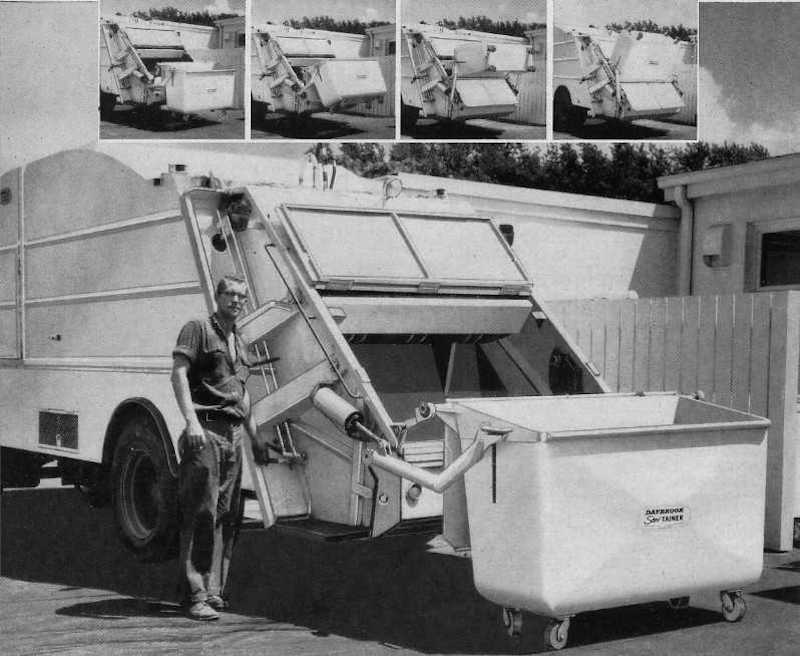
Above: A Daybrook Power Packer hoists a 'Sani-Tainer' portable container
The Daybrook Power Packer was identical to the Herman Ram-Pak, a body designed and patented by George B. Wood, brother and business partner of world-renowned industrialist Garfield A. Wood. Although the Herman Body Company was still listing their version in the 1956 Municipal Index, Daybrook took over the license and began advertising the Power-Packer as early as January, 1957. The Daybrook Hydraulic Hoist Company was founded just before the second world war, and had supplied portable bridges for the Army. By 1954, they were owned by Young Spring & Wire Company, and eventually became known as the Daybrook Equipment division, building various truck bodies and cranes as well as the Power Packer in their plant at Bowling Green, Ohio.
A description of the original Herman Ram-Pak and early Daybrook Power-Packer may be found in the Herman page here at Classic Refuse Trucks (see link at the bottom of this page). In 1956, George Wood filed a second patent for improvements to his design, which would eventually be incorporated into the Power-Packer. The biggest change came in the form of a flexible, roll-up type belt, which replaced the solid steel follower plate of the original model. As can be seen from the illustration below, it enlarged the hopper area considerably, with the claimed benefit of "tumbling" the refuse which was supposed to reduce voids in the refuse load prior to compaction, and result in more uniform overall load densities.
The improved version is known to have been in production no later than 1958. Like the original, this improved version utilized a sweeper blade (green highlights) and crusher blade (red highlights) working in conjunction, but was now powered by twin hydraulic cylinders. This was a notable improvement, since the load upon the sweep panel would have probably been particularly heavy.
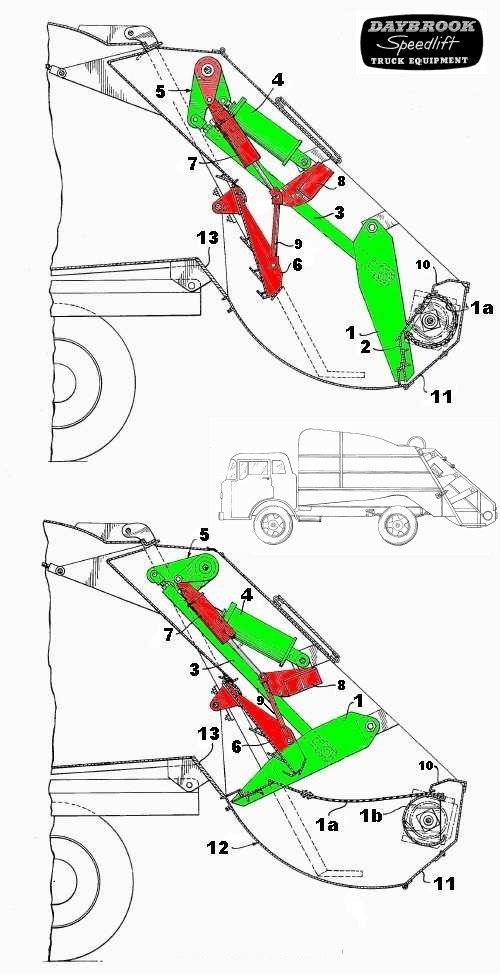 In top drawing, refuse is ready to be loaded over the hopper sill (10) and the retracted flexible floor (1a), falling into the hopper ahead of the sweep panel (2). As before, a pair of pivoting links (1) on either side of the inner tailgate are connected push bars (3). The push bars are in turn connected at their upper ends to a crankshaft (5) which is turned by twin hydraulic cylinders (4), of which only one is shown in this illustration. Like the Ram-Pak, the crusher blade was driven by a compensator cylinder (7) hooked to the same crankshaft as the sweep panel, but note the change in shape of the crusher blade (6), and the use of solid links (9) from the rocker panel (8).
In top drawing, refuse is ready to be loaded over the hopper sill (10) and the retracted flexible floor (1a), falling into the hopper ahead of the sweep panel (2). As before, a pair of pivoting links (1) on either side of the inner tailgate are connected push bars (3). The push bars are in turn connected at their upper ends to a crankshaft (5) which is turned by twin hydraulic cylinders (4), of which only one is shown in this illustration. Like the Ram-Pak, the crusher blade was driven by a compensator cylinder (7) hooked to the same crankshaft as the sweep panel, but note the change in shape of the crusher blade (6), and the use of solid links (9) from the rocker panel (8).
In the lower drawing, we see the cycle commence with the main cylinders (4) fully extended, advancing the sweep panel to scrape the hopper floor (12), and push the load between the crusher blade (6) and the anvil (13). Baffles, looking much like "teeth" on the inside face of the crusher plate were added to help retain the previously crushed load. The cycle was continuous and fully automatic, and allowed new refuse to be loaded on top of the flexible floor (1a) without interruption. The rewinding of the flexible floor onto the drum (1b) was done by via a cable (not shown), with one end wound around a sheave affixed to the drum (1b) and the other affixed to the push bar (3), whereby the return stroke of the bar would rewind the drum, keeping it in synchronization with the packing mechanism.
In successive phases, main cylinders (4) would alternately retract, pushing the sweep panel rearward to the first position and lowering the crusher blade to pre-pack refuse between blade (6) and anvil (13), and then extend to force new refuse under the crusher and the pre-crushed load into the body. This back and forth cycling system was termed F.C.P., or Force-Crush-Pack in trade ads which stressed the benefits of continuous loading and pre-crushing. Among Power-Packer's contemporaries, only Roto-Pac offered continuous loading, and only the Sicard Sanivan had a pre-crushing compaction method.

Simplified drawing above uses same reference numbers to better illustrate F.C.P. action, particularly how the flexible belt false floor (1a) functioned to prevent refuse from falling behind the sweep panel (2) during the packing cycle
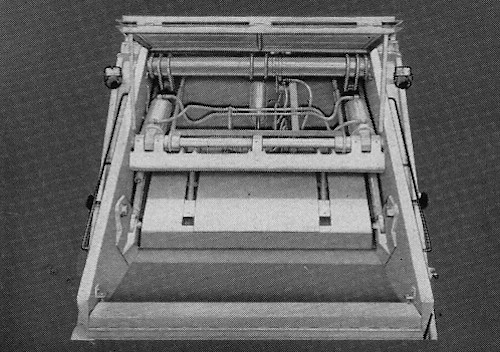
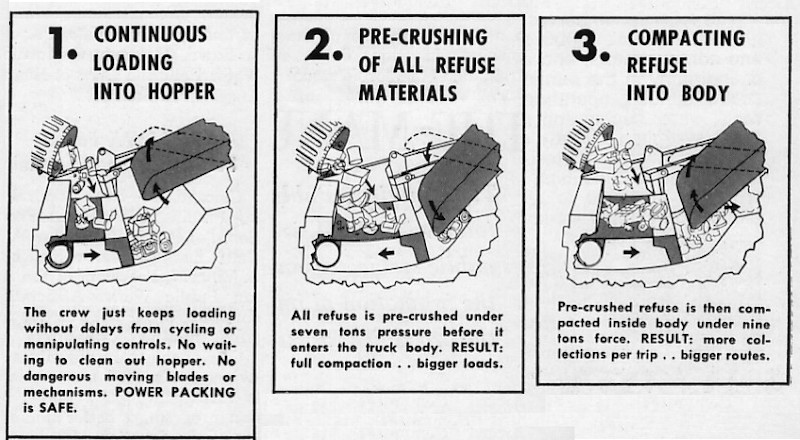
|
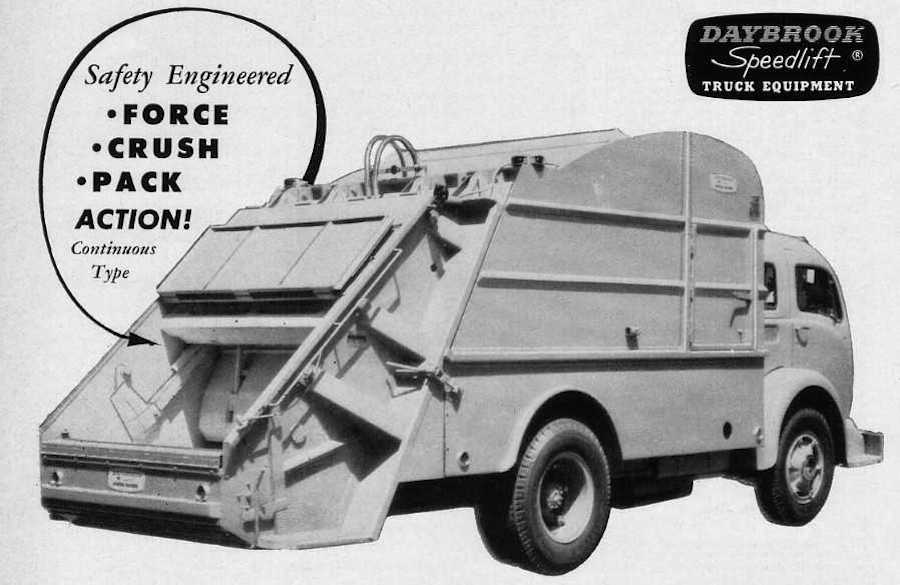
Image from a 1959 Daybrook advertisement
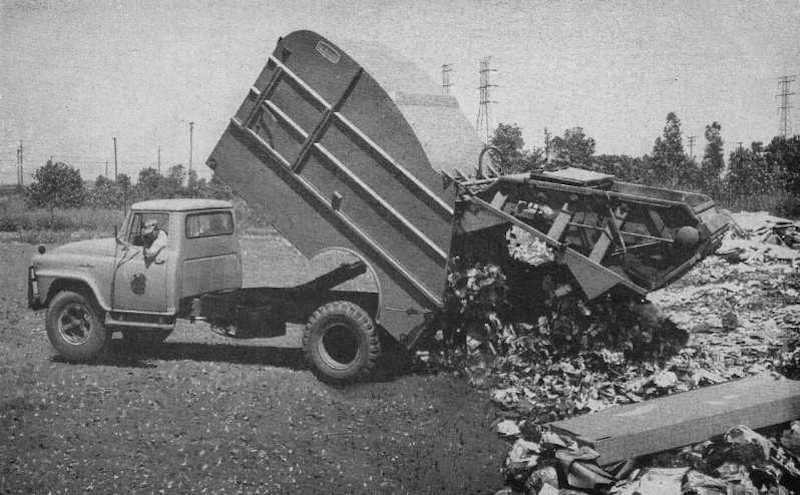
City of Hammond, Indiana Power packer tipping in 1961
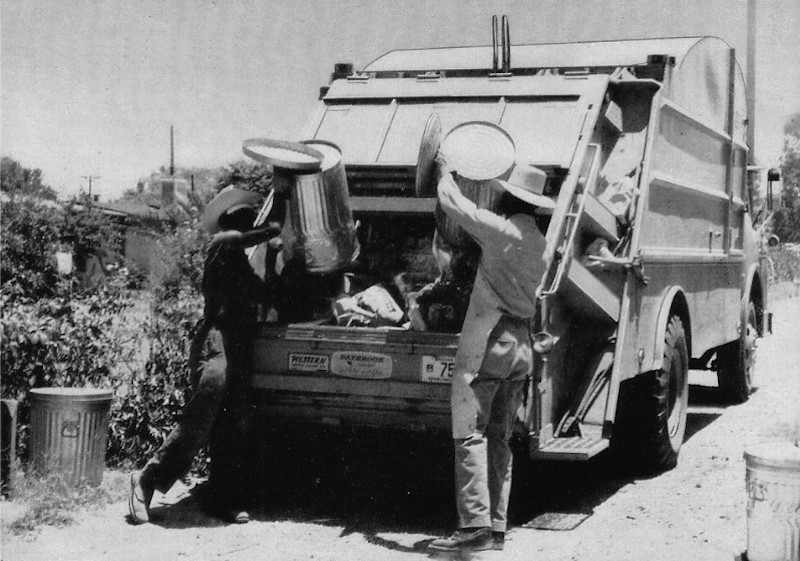
Crew from the City of Phoenix, Arizona loading one of the 29 Power Packers they owned in 1959
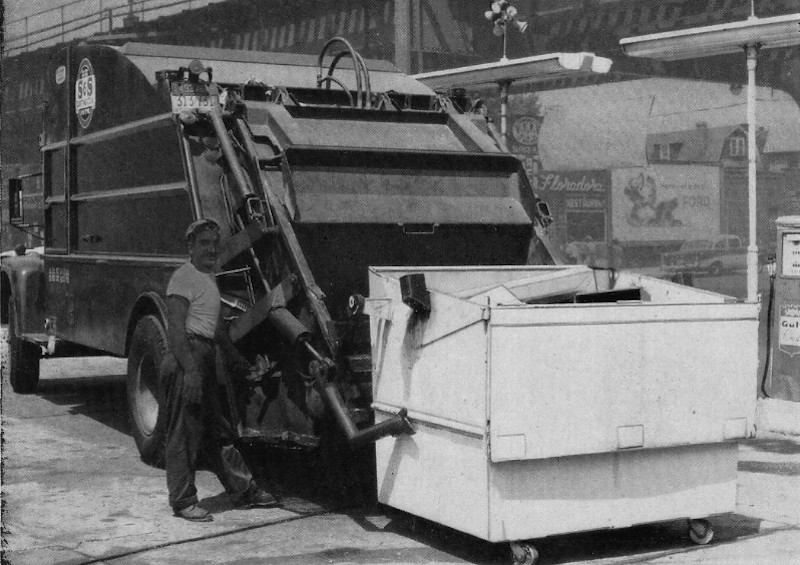
S & S Carting of New York used Power Packers such as this one, hooking up to a 3 yard container in 1960
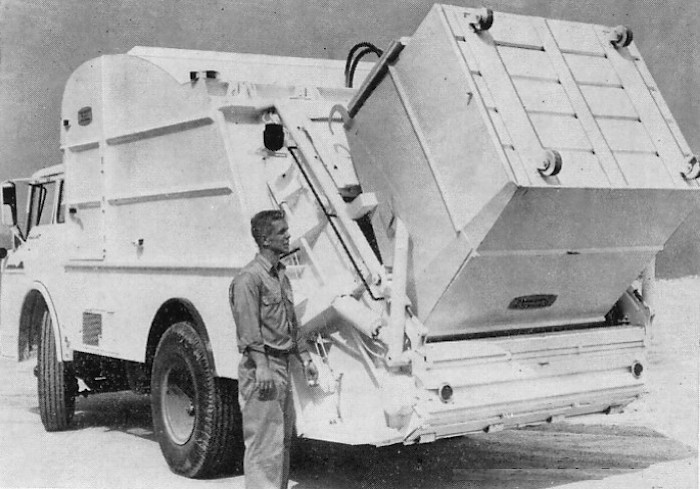
3 yard container dumping
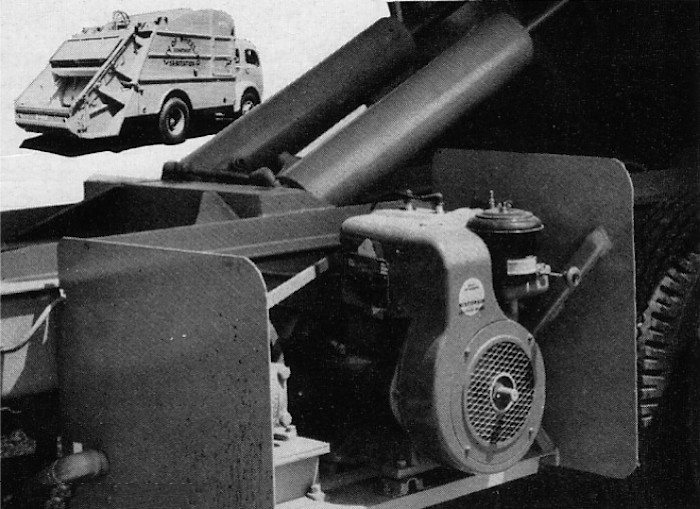
Optional auxiliary engine driving hydraulic pump allowed Daybrook to "pack on the go". Shown here is an twin-cylinder air-cooled Wisconsin THD
The Final Years
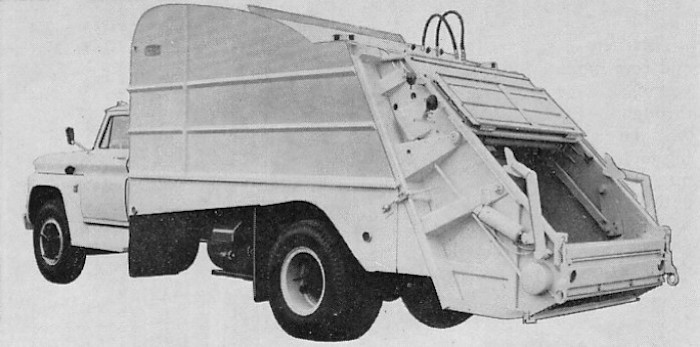
Above: One of the last Daybrook Power Packers of the mid-1960s. The flexible floor rewind spool and cable guide tube are clearly visible in this view of the left side tailgate, as is one of the push bars inside the hopper. Missing is the rocker panel, which should be visible at the top of the hopper opening, where instead we see a tubular support member which identifies this as a late model equipped with a third hydraulic cylinder powering the crusher plate (as described below).
The last and perhaps greatest improvement to the Power Packer came in 1963, with the addition of a third hydraulic cylinder to directly operate the completely redesigned crusher panel (highlighted in red, left illustration). This robust new design not only eliminated the rocker panel and mechanical linkage of the previous versions, but would appear to have given the crusher panel much more ability to assist in consolidating the the load, especially as the body became filled.
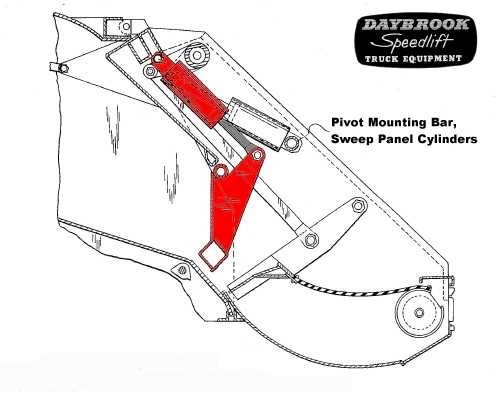
Though little else changed, there is at least one visual cue for identifying late model versions; in the illustration, note the pivot mounting bar for the sweep panel hydraulic cylinders, and then look at the photo above and the images on previous pages. The tube shaped support is clearly visible in the photo above, just above the hopper opening. On the earlier versions, the angular rocker panel is always seen at the top of the hopper opening.
|
Apparently, the entire Daybrook Truck Equipment Division was sold by Young Spring and Wire to to Paul Hardeman Inc., a name which began to appear in Daybrook ads as early as 1964. The Power Packer refuse bodies were advertised for a few more years, with the company trading as Daybrook-Ottowa by 1966. By 1968 it was no longer listed in the Municipal Index. Within the increasingly competitive refuse body industry of the mid 1960s, new designs with previously unimaginable power were beginning their eventual domination of the market, and perhaps the owners "saw the writing on the wall". Though short-lived and now obscured by the passage of time, the Power Packer was an important and once viable player in the industry, a true classic refuse truck.
A version of the Power Packer was also produced in the Netherlands by Kronenburg, and a Canadian version called the Wood Load-Crusher is also known to have been built.
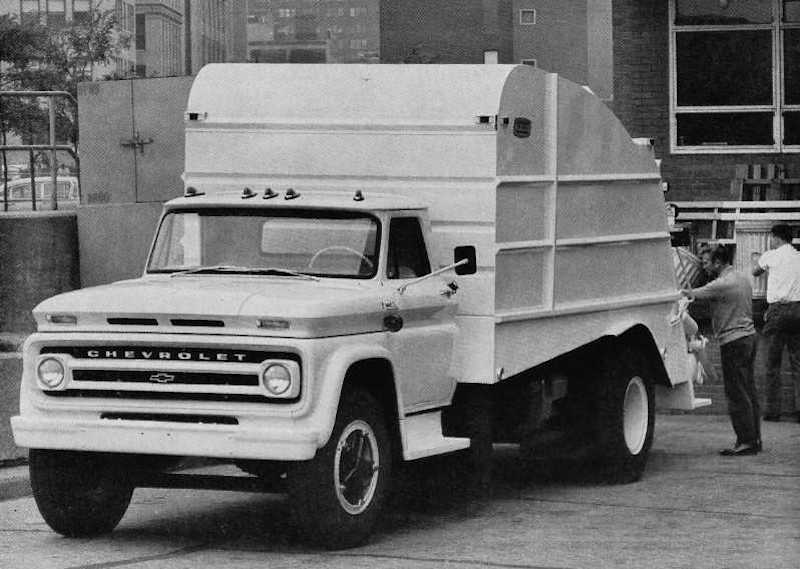
Power Packer on a 1964 Chevrolet
SIDEBAR: CONTINUOUS LOADERS vs. BATCH LOADERS
The Daybrook Power Packer was a U.S, built continuous-type loader, but competed against a slate of rivals which were almost universally of the batch-loading type. Simply put, the term batch loader refers to any type of refuse truck in which a quantity of refuse (a batch) is first loaded, and then compacted by the mechanism to make room for the next batch. With batch loaders, the operator typically has to wait until at least part of the packing cycle is completed before reloading may commence. The amount of time he must wait until reloading begins is called the re-load time, and could be as little as four seconds on a Gar Wood LP-500, or as much as twenty seconds on a Leach Packmaster. With full-travel side loaders such as the Pak-Mor, the entire cycle would have to complete before anything else could be loaded. The same was true of both the Heil Colectomatic and Sicard Sanivan rear loaders.
With continuous-loaders, refuse is constantly packed by the mechanism, typically in small increments as the collection crew loads the vehicle. There is no reload time, and the crew may continue to add refuse as fast as the mechanism will digest it. It is this school of design that found much success in post-war Europe, in contrast to the American trend toward batch loaders. European continuous loaders of the Rey and Ochsner type are among some of the first rear load packers ever built, with examples being in use as early as 1933. Their simple, plunger-type mechanisms are perhaps best known today from two famous British makes; The SD Pakamatic and Dennis Paxit. A look at a Paxit diagram perhaps best illustrates this method:

(1) Refuse is loaded into hopper (2) Plunger pushes refuse from below, "inverted drawer" shape of plunger prevents refuse from falling behind mechanism (3) Pivoting panel sweeps and packs refuse into body (the SD Pakamatic used a similar method, but excluded upper packer panel and instead forced refuse beneath fixed tines)
The Dennis Paxit method illustrated above closely resembles that of the Power Packer, especially the last Daybrook version. George Wood may quite possibly have been influenced by European refuse truck builders, since his own designs competed against them in the export market. He was surely aware of them. Along with the DSNY Escalator-Loader, the Heil Conveyor and the Roto-Pac, the Power Packer is among the few serious attempts by an American company to market a continuous-type rear loader.
|
SELECTED PATENTS
|
Patent # |
Description |
Inventor |
Assignee |
Date |
|
US2767867 |
Refuse Vehicle Loading Device |
Wood |
|
May 7, 1954 |
|
US2888158 |
Refuse Vehicle Loading Devices |
Wood |
|
August 30, 1956 |
|
US3063586 |
Refuse Handling Vehicle |
Apppleman |
Young Spring & Wire |
November 20, 1959 |
|
US3254782 |
Refuse Vehicle Packer |
Mold |
Paul Hardeman Inc. |
October 14, 1964 |

4/2/05 (revised 8/29/09)
© 2005
All Rights Reserved
Logos shown are the trademarks of respective manufacturers
Photos from factory brochures/trade advertisements except as noted
|
|
| |